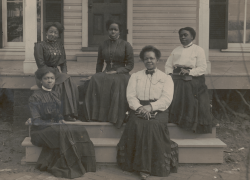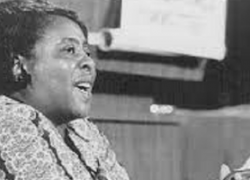
Growing up, I was usually one of only a few African American students in my class, and during Black History Month each February, I felt a great sense of pride as we learned about the achievements of people who looked like me.
I recall my mom taking me to the library to check out books related to black history, and my musician father exposing me to Black music legends, sharing his personal insight about their impact on American culture. My father was a member of The Dramatics, a national recording Soul R&B group that toured with icons such as James Brown and appeared on iconic TV shows American Bandstand and Soul Train several times.
One year in school, I wrote an essay about Rosa Parks and her impact on the civil rights movement. When I told my grandmother about it, she shared that Rosa and I were related by marriage; Rosa’s husband, Raymond Parks, was our cousin!
My grandmother arranged for me to meet Rosa at her home in Detroit, a meeting that has continued to influence me ever since. She was small of stature, but her presence filled the room. Her determination was an inspiration. I asked her if she had felt scared that December day on the bus in Montgomery and she said no. It wasn’t fear she had felt; it was resolve, because: “It was time.” What I have held dearest about Rosa over the years is not only the words she spoke, but even more so, the feelings she evoked. Rosa had a quiet strength that extended to others.
Meeting Rosa was one of the greatest honors of my life. I now realize that the experience of seeing her in person—and truly understanding how one small voice can change a society—along with other early experiences, laid the foundation for the work I do today. They taught me the power of tenacity in advocating for change, something I’m proud to do every day as a senior communications and outreach advisor in the U.S. Department of Labor’s Office of Disability Employment Policy (ODEP). At ODEP, we work to increase employment opportunities for people with disabilities, including those with intersectional identities.
I am one of those people. I have a nonapparent disability. I wasn’t always open about acknowledging this at work, however, because I feared people might make erroneous assumptions about what I could and could not do. But today I am fortunate to work in an inclusive environment, one where I can ask for the accommodations I need to perform my best, without fear of stigma or discrimination.
I now understand that, like my cultural heritage, my disability is an important part of who I am. So, I’m grateful to the many leaders, from all backgrounds, who paved the way for me to feel safe and protected at work and valued for the many perspectives I bring to the table. Given my particular journey, during Black History Month I pay special homage to a number of leaders making history today—such as Haben Girma, Andraéa LaVant and others—who are shining a light on the intersection between race and disability.
In the years to come, I hope America’s youth will learn about these and many other trailblazers during Black History Month, and hopefully every month. For Black youth with disabilities, I am confident the effect will be especially powerful, as they learn about people who look like them, on multiple levels. For my part, I will continue to draw on the courage and strength of those who came before me to fuel my work at ODEP.
Tonya Brown is a Senior Communications & Outreach Advisor in the department's Office of Disability Employment Policy.

 U.S. Department of Labor Blog
U.S. Department of Labor Blog


